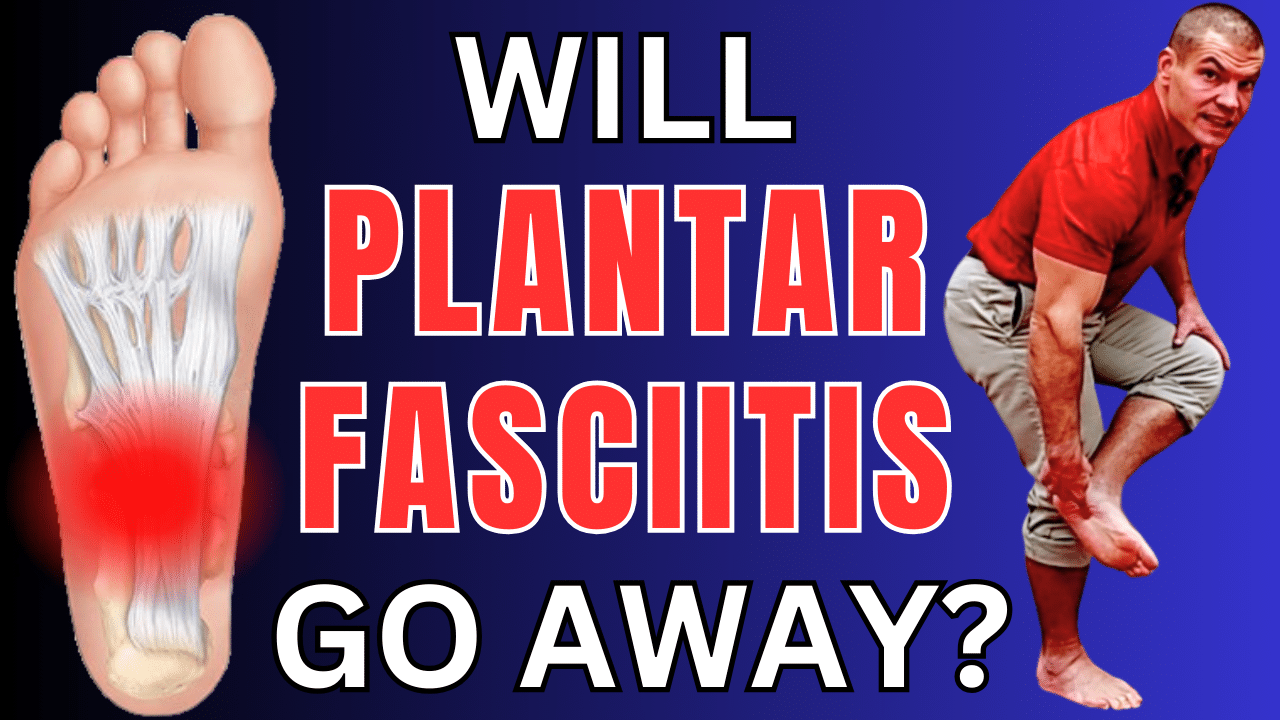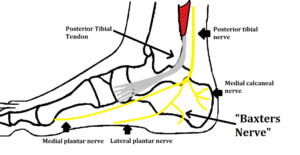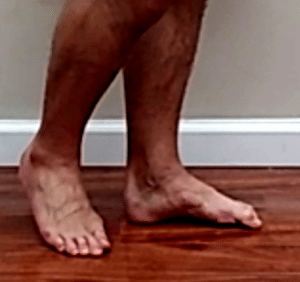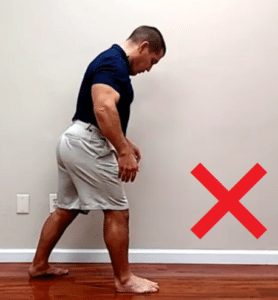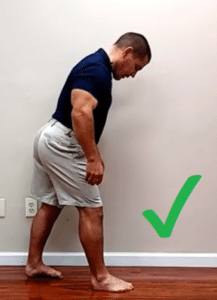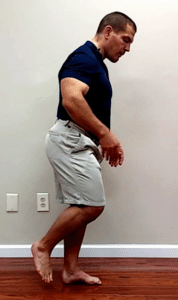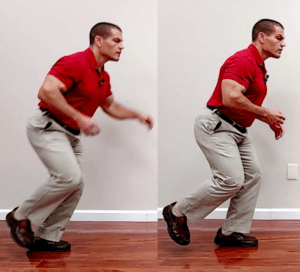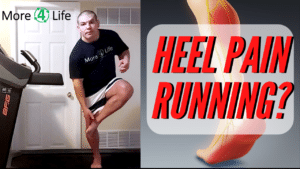Plantar Fasciitis Usually WILL NOT Go Away On It's Own
Plantar fasciitis can go away on it's own, but most of the time, it will not. Watch the video to learn why, plus what you can do MAKE your plantar fasciitis go away for good.

Why Plantar Fasciitis Usually Will Not Go Away On Its Own
The reason that planner fasciitis usually won't go away on its own is that plantar fasciitis is an overuse injury.
It's caused from using poor mechanics when walking and/or running over a long period of time.
Just in case you don't know, plantar fasciitis means pain on the bottom of the foot.
Literally, it means "inflammation of the fascia on the bottom of the foot".
However, in most cases of plantar fasciitis, the fascia isn't actually inflamed. Sometimes it's not even the fascia itself that's causing pain.
For the purpose of this video though, we're just going to refer to planner fasciitis as any type of pain on the bottom of the foot.
Again that's usually caused by poor walking or running mechanics thousands of times per day for weeks, months,, or years on end.
Will Plantar Fasciitis Go Away With Rest?
When you have plantar fasciitis, one of the most common things that people will tell you is to rest.
Resting does help relieve the symptoms of plantar fasciitis, but you can't rest all the time.
You have to be on your feet.
Unless you're going to take several weeks or months off of your feet completely, you're still going to continue to re-irritate your foot every time you take a step if you're using improper mechanics.
What if I'm willing to stay off my feet?
Let's say that you do take weeks or months off of your foot, that you go around with crutches, a knee scooter, or a walking boot.
That may relieve the pain temporarily.
The problem when you do that is that is makes your foot and ankle get stiff.
This in turn only makes the problem worse in the long term.
Once you get back to the activities that were bothering it in the first place, if your ankle stiff, you'll end up overpronating or flattening your foot down too much.
How To Cure Plantar Fasciitis Permanently
The only way to cure plantar fasciitis permanently is to fix the faulty mechanics that caused it in the first place.
How To Fix Plantar Fasciitis From Overpronation
Often, plantar fasciitis is due to overpronation or your foot flattening too much when you're walking.
That can be due to stiffness in your ankle or calves.
It can be due to weakness in your foot muscles or weakness in your hip muscles.
When you overpronate, the inner side of your heel and foot can smash down on:
- The plantar fascia
- Your foot arch muscles
- Baxter's nerve
If you do have a problem where you overpronates or flatten your foot too much, you want to learn to walk with an arch in your foot.
Make sure that you only take steps long enough that you don't have to overpronate your foot when walking.
How To Fix Plantar Fasciitis From Underpronation (Over-Supination)
This is just the opposite of the prior problem.
A high-arch foot doesn't absorb shock well.
Therefore, if you have a high-arch foot, it's important to improve shock absorption when walking and especially running.
Having good flexibility in your calves can help you absorb shock in other places besides just your foot.
Footwear is also important though.
If you have a high arch, having shoes that are well-cushioned and/or shock-absorbing orthotics (not hard orthotics) can help.
Spenco Ground Control Shoe Insoles for W...
38% OffExercises For Plantar Fasciitis
What about exercises for plantar fasciitis?
Many people do calf stretches for plantar fasciitis, and calf stretches are important.
However, if you're going to stretch your calves, you want to make sure you're doing it properly.
How To Stretch Your Calves Properly
When people stretch their calves, often they'll flatten their foot out as they're stretching their calves.
However, that defeats the purpose. If you have an overpronation problem already, it just plays further into the problem.
So make sure not to allow your arch to flatten when stretching your calves.
Strengthening Exercises For Plantar Fasciitis
Another thing that's really important is strengthening the muscles in the arch of your foot
You can do that just by gripping the ground with your toes and then practicing standing on one leg, keeping the arch lifted.
In addition to strengthening your foot arch muscles, this also helps strengthen your hip muscles.
Your hips help balance your body over your foot as you're going to walk or run.
The BEST Plantar Fasciitis Exercise
Now, the best exercise is being able to do that all dynamically.
That means being able to keep you foot arch lifted while stretching your calves, and while strengthening your glutes at the same time.
You can learn how to do that here.
You take thousands of steps every day, so again, it's important to be able to walk properly in order to cure plantar fasciitis permanently.
Exercise To Fix Plantar Fasciitis When Running
If you only have plantar fasciitis when running, then you'll need to be able to absorb shock better.
Stretching your calves can help, as can wearing proper shoes / orthotics.
However, you also need to be able to absorb the ground reaction force from running using your hip, thigh, ankle, and foot muscles.
One way to practice doing this is doing single leg hops.
To do this, hop and then stick your landing without wobbling or double hopping.
Then repeat over and over again. Start with 10-20 hops per set and gradually build up.
Remember, you take about 1600 strides per mile if you have a 1 meter stride length, so the key here is building up to high repetitions.
Additionally, improving your running form can help fix plantar fasciitis pain from running.
Conclusion
Most of the time, plantar fasciitis will NOT go away on it's own.
In order to make it go away, you usually have to proactively do something about it.
Fortunately, that rarely ever requires invasive treatments like cortisone injections or surgery.
It does however require changing making some changes to your walking and/or running mechanics since you take thousands of steps every day.
Need Help For Foot Pain?
If you live in the St. Louis area and need help for plantar fasciitis, we'd be happy to help you figure out what flexibility and strength problems are contributing to your foot pain.
Additionally, we'll help you fix your walking and/or running mechanics so that you not only get your foot pain to go away, but that you learn how to keep it from coming back in the future.
If that sounds good to you, tap the button below to request an appointment with one of our specialist physical therapists.
Like this post? Check out some of our other posts about foot pain and plantar fasciitis.
When Is Foot Arch Pain Not Plantar Fasciitis?
How To Relieve Pain In Foot In The Morning

